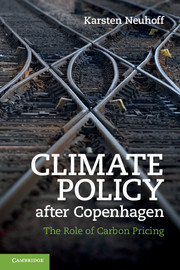Book contents
- Frontmatter
- Contents
- List of figures
- List of tables
- List of boxes
- Acknowledgements
- List of abbreviations
- 1 Introduction
- 2 The role of a climate policy mix
- 3 Implementing a carbon price: the example of cap and trade
- 4 Shifting investment to low-carbon choices
- 5 Co-operation among developed countries: a role for carbon markets?
- 6 A world of different carbon prices
- 7 International support for low-carbon growth in developing countries
- 8 Conclusion
- References
- Index
4 - Shifting investment to low-carbon choices
Published online by Cambridge University Press: 05 June 2012
- Frontmatter
- Contents
- List of figures
- List of tables
- List of boxes
- Acknowledgements
- List of abbreviations
- 1 Introduction
- 2 The role of a climate policy mix
- 3 Implementing a carbon price: the example of cap and trade
- 4 Shifting investment to low-carbon choices
- 5 Co-operation among developed countries: a role for carbon markets?
- 6 A world of different carbon prices
- 7 International support for low-carbon growth in developing countries
- 8 Conclusion
- References
- Index
Summary
Most carbon-emissions reduction is expected from investment and reinvestment choices in power, transport, housing and industry. Hence, one of the main purposes of the carbon-price signal is to drive investment choices. These choices, especially in the infrastructure sector, are typically associated with long time frames over which returns are expected to finance the initial investment. This does not automatically imply, as frequently argued, that infrastructure and technology choice cannot evolve rapidly.
Figure 4.1 illustrates the rapid investment in combined-cycle gas turbines for power generation which occurred after the liberalisation of the UK gas and electricity markets in the early 1990s. Within half a decade, the new technology captured the biggest market share of UK power generation. This illustrates that market environments can drive rapid change if the appropriate framework creates sufficient certainty and incentives for investors.
The European Union emissions-trading scheme has put carbon prices on the agenda with executives of emitting companies. The cost of carbon is relevant to the investment decisions of 73 per cent of energy-intensive industries in Europe. The Stern Review (2006) on the economics of climate change highlights some concerns about the impact of uncertainty on low-carbon investment choices:
In order to influence behaviour and investment decisions, investors and consumers must believe that the carbon price will be maintained into the future. […] If there is a lack of confidence that climate change policies will persist, then businesses may not factor a carbon price into their decision-making. But establishing credibility takes time. […] In this transitional period, while the credibility of policy is still being established and the international framework is taking shape, it is critical that governments consider how to avoid the risks of locking into a high-carbon infrastructure, including considering whether any additional measures may be justified to reduce the risks.
- Type
- Chapter
- Information
- Climate Policy after CopenhagenThe Role of Carbon Pricing, pp. 97 - 131Publisher: Cambridge University PressPrint publication year: 2011



